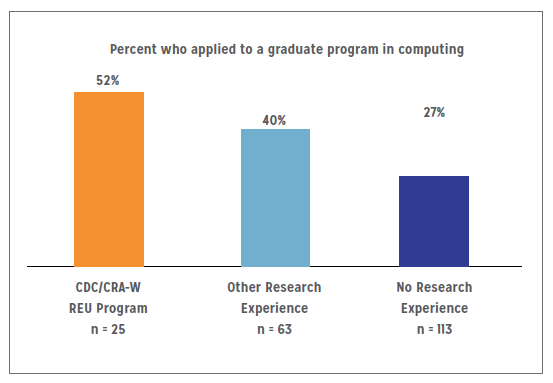Racial/ethnic Minority Students Who are CDC/CRA-W REU Participants are Particularly Likely to Apply to a Graduate Program in Computing

A sample of racial/ethnic minority undergraduate students graduating with a computing major (N = 201) reported whether they had applied to a graduate program in the fall. Students who had participated in a CDC/CRA-W REU program were significantly more likely to have applied to graduate program in computing than their peers with no undergraduate research experience (p < .05). Among students who had other research experiences and students with no research experience, there was no difference in graduate school application rates (p = .13). Importantly, this analysis controlled for students’ college GPA and parental education level, indicating that participating in a CDC/CRA-W REU program predicted applying to a computing graduate program over and above GPA and parental education level.
Data source: aggregated data from the CRA’s annual Data Buddies surveys for graduating students, collected during the spring of 2011, 2012, 2013, 2014, and 2015. Racial/ethnic minority students: African American/Black (n = 76); Hispanic/Latina/o (n = 39); Native Hawaiian/Pacific Islander (n = 2); Mixed race/ethnicity, where students identified with at least one of the following groups: African American/Black, Hispanic/Latina/o, or Native Hawaiian/Pacific Islander (n = 85). Other research experience: formal research experience at students’ home institution or another institution either during the summer or school year.
 This analysis is brought to you by the CRA’s Center for Evaluating the Research Pipeline (CERP). CERP provides social science research and comparative evaluation for the computing community. To learn more about CERP, visit our website at https://cra.org/cerp/.
This analysis is brought to you by the CRA’s Center for Evaluating the Research Pipeline (CERP). CERP provides social science research and comparative evaluation for the computing community. To learn more about CERP, visit our website at https://cra.org/cerp/.
This material is based upon work supported by the National Science Foundation under Grant Number (CNS-1246649; and/ or DUE-1431112). Any opinions, findings, and conclusions or recommendations expressed in this material are those of the author(s) and do not necessarily reflect the views of the National Science Foundation.









